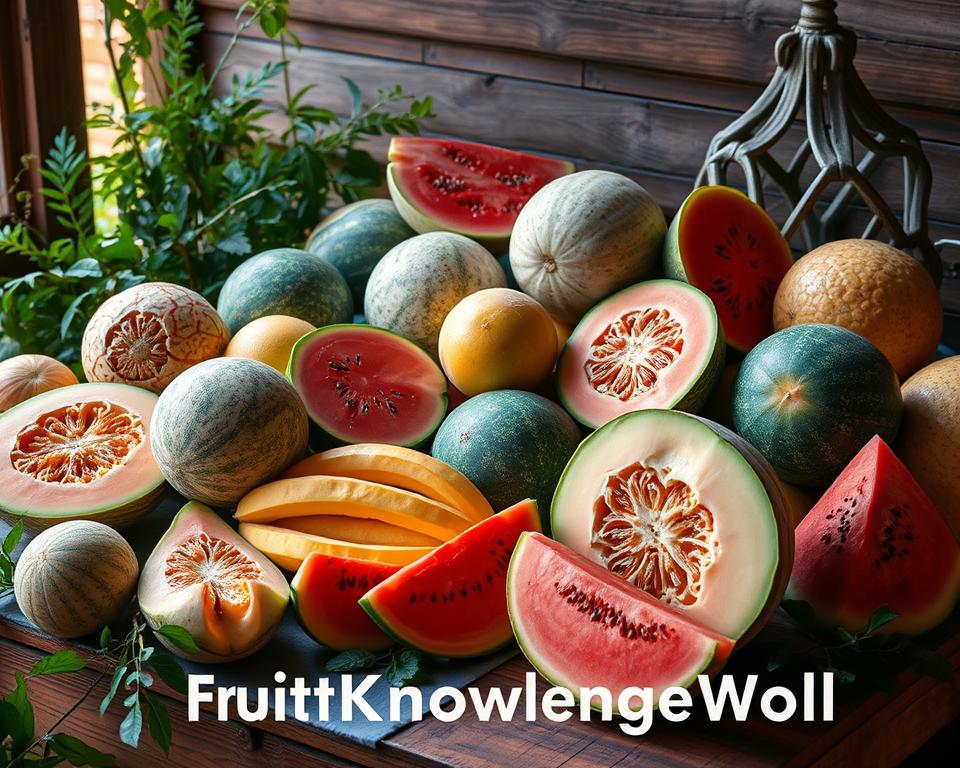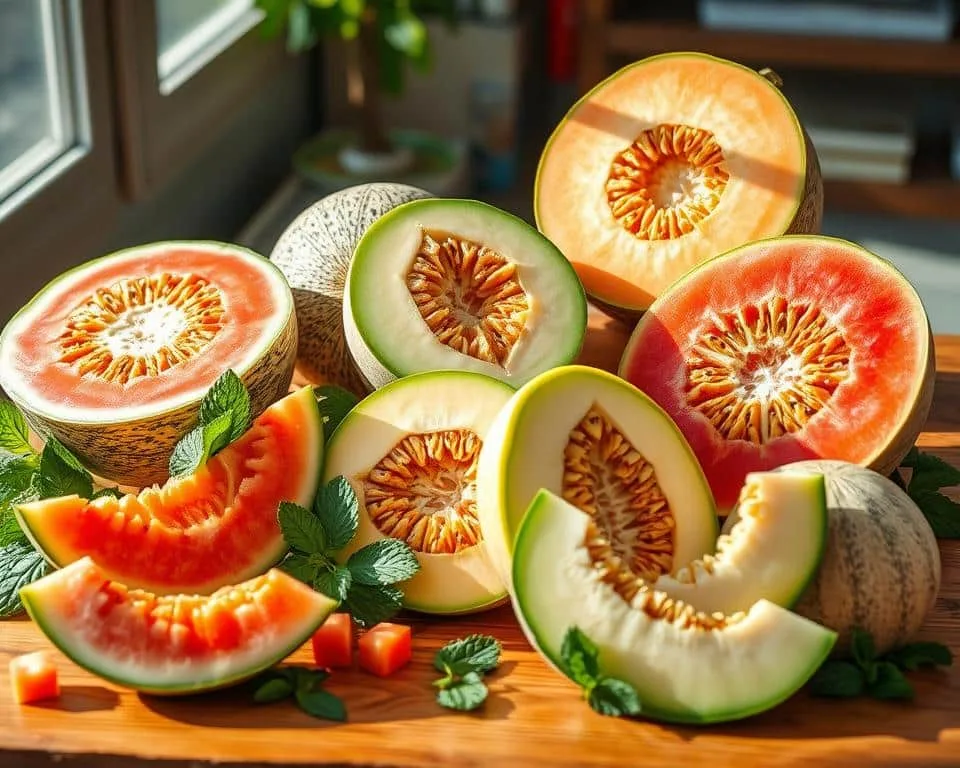Melons are a beloved summer treat. They bring sweetness and refreshment to any occasion. Learn about the different types, like watermelons and muskmelons, in this article. We’ll show you how to pick the perfect melon. You’ll also discover the unique traits of each kind and the best ways to prepare them.
Key Takeaways
- Melons are classified under main genera: Citrullus, Cucumis, Benincasa, and Momordica.
- Common types include watermelon, cantaloupe, honeydew, and casaba.
- Watermelons have high water content and are rich in the antioxidant lycopene.
- Muskmelons like cantaloupe, honeydew, and Hami melon offer diverse flavors and textures.
- Choose ripe melons by their weight, rind texture, and aroma for the best taste.
Introduction to Melons
Melons are a key part of summer fruits, known for their sweet taste. They belong to the gourd family Cucurbitaceae. For thousands of years, people around the world have enjoyed growing them.
Melons are not just tasty. They’re also healthy, providing hydration during hot months.

Let’s talk about melon varieties. You might know cantaloupe, honeydew, and watermelons. Each has its own flavor and health perks.
Cantaloupe benefits, for example, include lots of vitamin C. It also has antioxidants for good health. Then there’s watermelon hydration, perfect for staying hydrated.
Melons vary in look, feel, and taste. They can be big or small, smooth or rough. The colors inside can vary too. Muskmelon types are diverse, including the North American cantaloupe. There is also the European cantaloupe and the winter melon.
| Country | Annual Production (Million Tonnes) |
|---|---|
| China | 13.83 |
| Turkey | 1.72 |
| India | 1.33 |
| Iran | 1.28 |
| Afghanistan | 0.79 |
| United States | 0.69 |
| Guatemala | 0.65 |
| Brazil | 0.61 |
This table shows the top melon producing countries. China, Turkey, and India lead the way. Melons are important worldwide for their taste and variety.
Types of Watermelons
Watermelons offer a wide variety, each with its own special taste. There are red ones full of antioxidants, sweet yellow ones, and the small but tasty Sugar Baby watermelons. Let’s look at why each type is special.
Red Watermelon
Red watermelons are known for their health benefits thanks to the antioxidants they contain. They’re the perfect size for outdoor events, weighing around 8 to 12 pounds. These melons like Crimson Sweet and Jubilee can get really big, going up to 45 pounds.
To learn more about watermelon varieties, including antioxidants in red watermelons, check out different types to find your favorite.
Yellow Watermelon
Want to try something new? Yellow watermelons have a sweet, honeyed taste and usually weigh less than eight pounds. The Yellow Doll variety is great for small families. Its golden flesh looks beautiful and tastes different too. Yellow watermelons have their own unique place in the watermelon family.
Sugar Baby Watermelon
The Sugar Baby watermelon is loved for its strong flavor despite its small size. It weighs between 9 to 13 pounds, making it ideal for small spaces. Its deep red inside is not only pretty but also delicious.
These melons also grow quickly, in just 72 to 100 days. That makes them a great choice for both gardeners and watermelon lovers.
Exploring Muskmelons
Enter the world of muskmelons. These include sweet cantaloupes, smooth honeydew, and super sweet Hami melons from China. We’ll look at their tastes, how fresh they are, and how to use them in cooking.

Cantaloupe
Cantaloupes are known for their sweet taste. They weigh between 4 to 8 pounds. Their orange flesh and netted rind make them a summer hit. They’re perfect in breakfast bowls or salads, adding a sweet, floral flavor.
Honeydew Melon
Honeydew melons are famous for their freshness and juicy texture. They have a pale green flesh. Cool and crisp, they’re great in fruit salads or as summer treats. Their smooth rind helps them last longer, making them a good choice for keeping.
Hami Melon
Hami melons are known for their crispiness and sweet taste. Originating from China, they’re elongated and juicy with a lime hint. Their unique sweet and crisp taste is perfect as a snack or in drinks.
| Muskmelon | Weight (lbs) | Flesh Color | Best Culinary Uses |
|---|---|---|---|
| Cantaloupe | 4-8 | Orange | Breakfast bowls, Salads |
| Honeydew Melon | 4-8 | Greenish-White, Pale Green | Fruit Salads, Summer Treats |
| Hami Melon | 4-7 | Orange | Snacks, Beverages |
Muskmelons love warm weather, from 60°F to 95°F. Spacing, timing, and careful handling help them grow well. Support the fruits to avoid ground damage. Also, protect them from pests. With good care, a rich harvest of muskmelons awaits.
Specialty Melons to Try
There’s a whole world of exotic melons out there. They offer a fresh and unique experience for melon lovers. The Charentais melon and the Piel de Sapo melon are two special kinds. They bring their own flavors and textures to your fruit bowl.
Trying these melons can change how you see seasonal fruits. They delight your taste buds with new, exciting tastes.
Charentais Melon
The Charentais melon is also called the French cantaloupe. It’s known for its amazing flavor. This melon has firm, dark-orange flesh. It’s sweet with a rich, musky smell. The seed cavity is small, so there’s more to eat. It’s a hit at farmer’s markets.
Because it’s delicate, the Charentais melon is best when it’s local. Eating this melon adds a French twist to your meals. It makes your fruit selection fancier.
Piel de Sapo Melon
The Piel de Sapo melon, or Christmas melon, is one of a kind. It looks unique and has a gentle taste. Its texture is harder than other melons. But, it gets sweeter as it ripens. These melons are big, weighing 6 to 9 pounds. They offer a nice change from more common melons.
Adding this melon to your fruit bowl will wow your guests. It makes your fruit choices more interesting.
Start an adventure with these exotic melons. Every bite of Charentais or Piel de Sapo melon opens up new tastes and textures. They promise health perks and a break from the usual.



